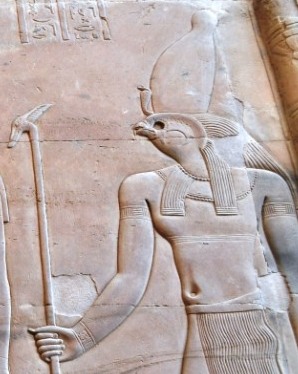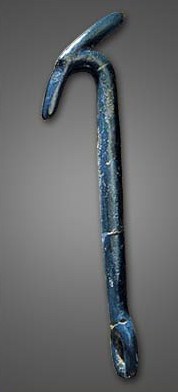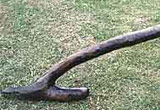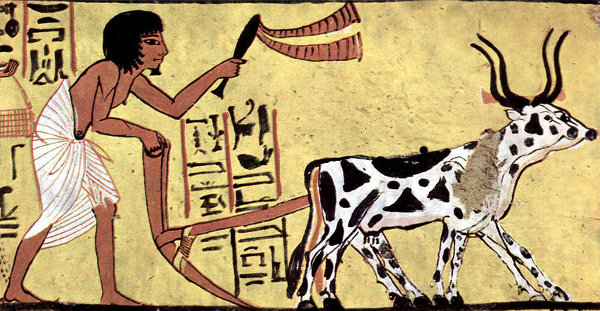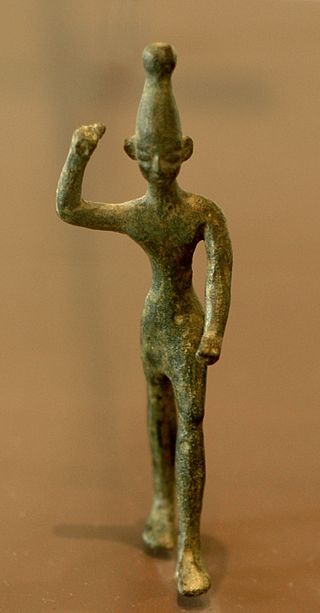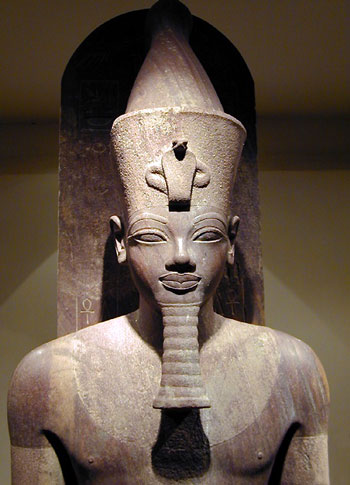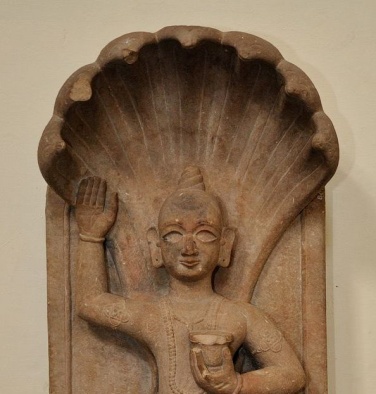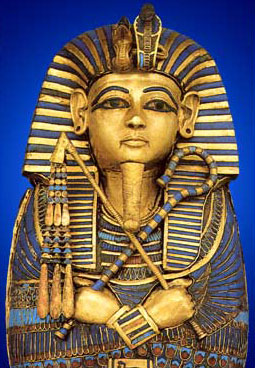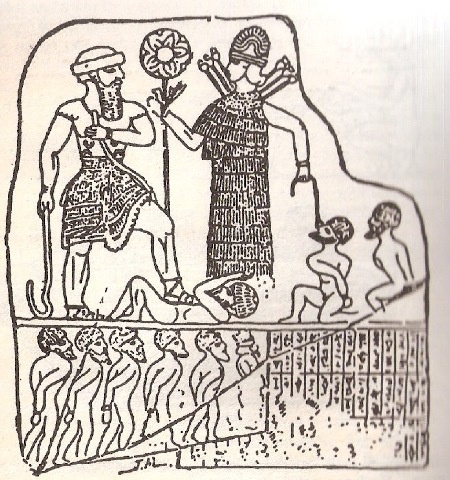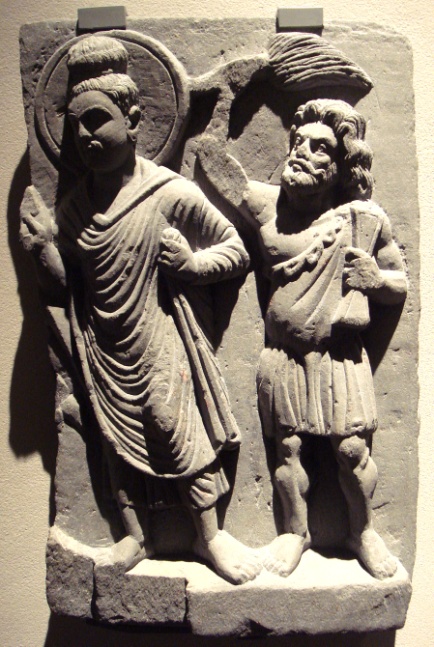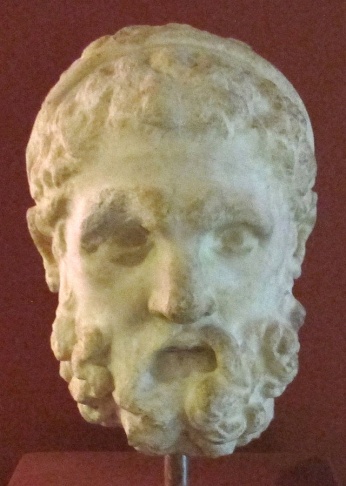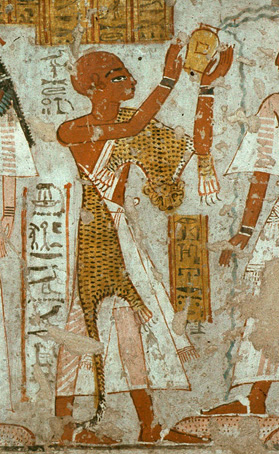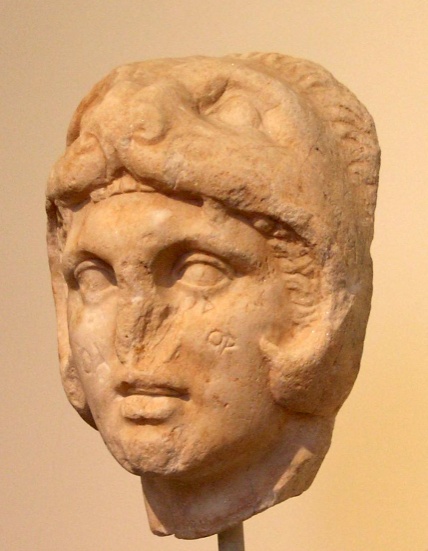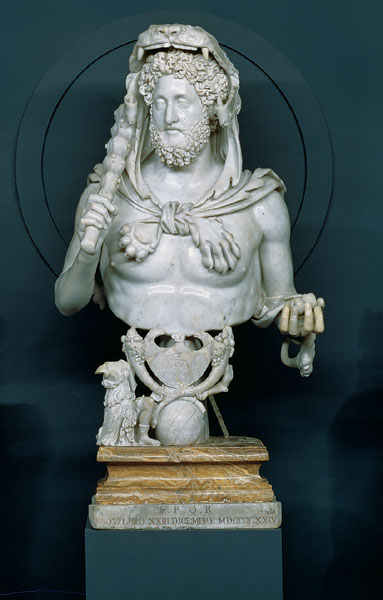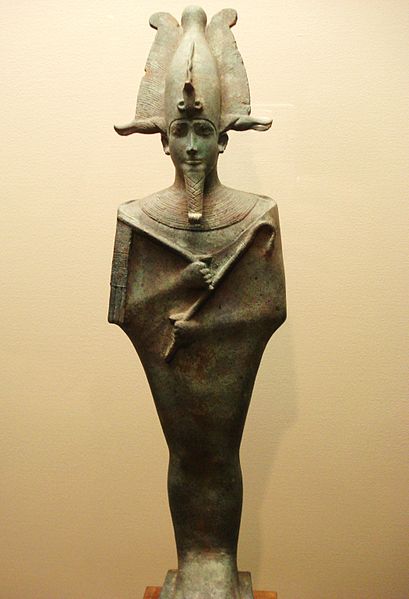See Part 1 of this article
Background
In Part 1 of this article I discussed about the exploits of the legendary hero Hercules in Egypt and Babylon. The statements of the Greek writers, as well as a large number of the symbolic correlations, indicate that Hercules was Balarama, the elder brother of Krishna. As per the ancient sources, Hercules-Balarama, on his arrival in Egypt, had stopped a flood on the Nile, deposed of a tyrant king called Busiris, and established his own son Ramesses (also known as Aegyptus) on the throne of Egypt, thereby kickstarting in new phase in Egyptian history which corresponds to the Naqada I Period (c. 4000 BC-3500 BC) of Predynastic Egypt.
He had subsequently travelled to Babylon, where he had set up an Order of priesthood on the likes of Egypt, founded the magnificent city of Babylon, and established a royal dynasty which ruled for thousands of years after him. After his death, he was deified by the Hebrews and Canaanites as the god Baal (or Bel), the tutelary deity of Babylon. Like Hercules and Balarama, Baal was regarded as a protector and a conqueror, the giver of victory, the god of rains and fertility, and his sacred symbols included the club and the pillar. At a subsequent period, the Phoenicians, who had emerged as a significant maritime culture in the Mediterranean around 1500 BC, worshipped a god called Melqart who was regarded as a powerful king, as the protector of the Phoenician colonies, and as a god of harvest. Melqart was also known as Belus, Baal Melqart, and the Tyrian Heracles which indicates that all of these epithets described the same person.
The evidence from the historical sources, and the iconographical details, indicate that a heroic person of extraordinary abilities, Hercules-Balarama, had travelled the globe many thousands of years ago. He had carried out many incredible acts of heroism, courage and benevolence, and came to be regarded as a symbol of strength, protection, fertility and kingship. He built massive fortified cities in many distant lands, and also started many royal dynasties. It was in Egypt, however, where Hercules-Balarama played an extremely significant role, which has largely remained unexplored. In this article, I will attempt to show, through an analysis of the regalia of the pharaoh that, all through the Dynastic Period, the Egyptian pharaoh was simply trying to imitate Hercules-Balarama – that great hero who had established the foundations of the institution of kingship in ancient Egypt way back in the Predynastic times, sometime around c.4000 BC.
The Plough and the Club
Diodorus Siculus had made a very interesting statement regarding the regalia of the Egyptian pharaoh. He said that the Egyptian pharaoh and the priests carried a scepter shaped like a plough:
“For all who have to do with the cult of the gods, they maintain, are [ritually] pure: the priests are shaved in the same way, they have the same robes and the type of scepter shaped like a plough, which also the kings have, who use tall pointed felt hats ending in a knob, with the snakes that they call the asp (aspis) coiled round them.”i
This plough-shaped scepter mentioned by Diodorus Siculus can be easily recognized as the “was scepter” (or “uas scepter”), which was carried by the Egyptian pharaohs, the priests, as well as some of their gods (Set, Anubis etc.), right from the earliest dynasties. The was scepter looks very much like a “scaled-down version” of the primitive ploughs that were used in ancient Egypt, as well as the plough that is generally depicted in the hands of Balarama; and it exactly resembles some of the Iron Age ploughs that have been found at the site of Oakbank, Scotland, in recent years.
It is, of course, odd to see the Egyptian pharaoh hold a plough-shaped scepter. The was scepter was not associated with “fertility and abundance”, as one would naturally expect. On the contrary, all throughout Dynastic Egypt, the was scepter was a symbol of “power” and “dominion”, and in later times, it also represented “control over the forces of chaos”. Egyptologists have no idea from where this scepter originated, and how such connotations got associated with it.
What we do know, however, is that the plough was one of the foremost symbols of Hercules-Balarama, who used it to build irrigation channels, found cities, and vanquish his enemies. Hence, it is possible that this symbol of the Predynastic King Belus became associated with “power” and “dominion” and was adopted by his successors, who wanted to proclaim that they were invested with the same power and authority as him. Interestingly, a was scepter excavated at Abydos dates to the Predynastic period, which agrees with the hypothesis that Hercules-Balarama had arrived in Egypt in the Predynastic times.
|
|
|
| Fig 1: Horus holding the was scepter, Kom Ombo, 2nd century BC. Credit: Bibhu Dev Misra | Fig 2: Balarama holding the plough. Rani ki Vav, Patan, Gujarat, 11th century AD. Source: http://travel.bhushavali.com |
|
|
|
|
|
|
| Fig 4: Iron Age plough found at Oakbank, Scotland. Source: bbc.co.uk | |
|
| |
| Fig 3: The was-scepter. Source: touregypt.net | Fig 5: Ancient plough used in Egypt. Source: blogs.discovery.com |
Another important artifact held by the pharaoh was the mace (ames scepter). It was a symbol of “royal might”; it invested the king with an air of invincibility, enabling him to crush all his enemies. The Narmer Palette (from c. 3100 BC) shows king Narmer, the first king of Dynastic Egypt, holding a mace in his upraised hand and smiting his enemy. Many subsequent pharaohs of Dynastic Egypt were also depicted in a similar fashion. In a Karnak relief, Seti I was depicted on foot, wielding a mace, crushing his enemies, accompanied by an inscription that read: “Your mace is over the head of every foreign land and their great ones fall victim to your sword”.
If we compare the relief of King Narmer in the Narmer palette, with the stele of Baal or the bronze figure of Baal from Ugarit, we can see a remarkable degree of similarity. Both King Narmer and Baal are depicted with a conical headdress and a beard, holding a mace in the upraised arm, and wearing a kilt. While King Narmer is smiting a prisoner, Baal is holding a tree-stem, which was one of his sacred symbols.
|
|
|
|
| Fig 6: The Narmer Palette showing King Narmer, weilding a mace, wearing the White Crown of Upper Egypt, and smiting a prisoner, from c. 3100 BC. Source: Wikipedia. | Fig 7: Stele of Baal, holding a club and the stem of a plant. Ugarit, c.1499-1299 BC. Source: Wikimedia Commons | Fig 8: Bronze figure of Baal, 12th century BC, Ugarit. Source: Wikipedia. |
As discussed in Part 1 of this article, Baal was definitely Balarama – both the historical accounts, as well as the symbolic connections attest to this. The club was one of the most important symbols of Baal (with which he had defeated Yam, the sea-god), and it was also the favored weapon of both Hercules and Balarama. Hence, two of the most prominent symbols of Hercules-Balarama – the plough and the mace – were both associated with the Egyptian pharaoh. It appears quite likely, therefore, that the Egyptian pharaoh was indeed imitating Hercules-Balarama.
The Serpent in the Crown
We have seen that the headdress of Baal (in the bronze figurine from Ugarit) is identical to the crown of King Narmer, who is wearing the “White Crown of Upper Egypt” (the Hedjet crown), which was described by Diodorus Siculus as a “tall pointed felt hat ending in a knob”. Equally striking is the headdress worn by Melqart (the Baal of Tyre), which looks exactly like the Atef crown worn by many Egyptian pharaohs. The Atef crown consists of the “White Crown of Upper Egypt” flanked by two ostrich feathers.
|
|
|
| Fig 9: The crown of Melqart. Source:blogdeifenici.it | Fig 10: The Atef crown of King Sahure, 5th Dynasty. Source: touregypt.net |
While the earliest example of the Atef crown dates to the 5th Dynasty, the “White Crown of Upper Egypt” has been found depicted on the Qustul incense burner from c. 3800 BC, which indicates that this symbol was in usage from the early Predynastic period, when Hercules-Balarama was supposed to have arrived in Egypt.
An important component of the pharaonic headdress was the Uraeus, which was a rearing cobra worn as a head ornament. The Uraeus was a symbol of “royalty and divine authority” throughout Dynastic Egypt. The pharaoh was recognized by wearing the Uraeus, which granted legitimacy to the ruler. It was regarded a symbol of the goddess Wadjet, who was the goddess of the Nile delta, and the protector of Lower Egypt. It was believed that the Uraeus protected the pharaoh by spitting fire on his enemies from the fiery eye of the goddess. Although the single uraeus is the most common form, there are instances of double serpents (double uraeus), three upright serpent heads (triple uraeus), with an even further increase in the number of serpents in the crown from the reign of Amenhotep III onwards.
|
|
|
|
| Fig 11: Uraeus crown of Amenhotep III. Source: http://www.passion-egyptienne.fr | Fig 12: Triple Uraeus crown of Queen Tiye. Source: http://www.passion-egyptienne.fr | Fig 13: The Uraeus diadem of Set I at Abydos, comprising of band of multiple serpents. Source: http://www.artofcounting.com |
The rearing serpent on the crown can also be found in the iconography of Balarama. Balarama was believed to be an incarnation of the cosmic serpent Ananta-Sesha, and was nearly always depicted with a serpent canopy over his head (usually a three, five or seven hooded serpent). In some depictions, Balarama is shown with a single rearing serpent on his head, which closely resembles the single uraeus crown.
|
|
|
|
| Fig 14: Balarama with a single rearing serpent on his crown. Source: www.metmuseum.org | Fig 15: Balarama with a three-hooded serpent canopy. Source: http://travel.bhushavali.com | Fig 16: Balarama with a seven-hooded serpent. Source: Wikimedia commons |
We can, therefore, see a very precise correlation between the many types of pharaonic crowns and the headdress of Hercules-Balarama. Baal wears an exact replica of the conical “White crown of Upper Egypt”, Melqart is depicted with the Atef crown, while the Uraeus, which was such an important component of the pharaoh’s headdress, corresponds to Balarama’s serpent canopy. The evidence keeps pointing to the same conclusion – that the Egyptian pharaoh had adopted the symbolic attributes of Hercules-Balarama.
The Crook and the Flail
Another pharaonic symbol of great significance is the crook and the flail, which were prominent insignias of kingship from the earliest dynasties. The crook (heqa) was a cane with a hooked handle, resembling the shepherd’s staff. It symbolized the pharaoh’s “rulership” over Egypt. It was even employed as the hieroglyph for the word “rule” or “ruler”. The flail (nekhakha) consisted of a short handle, with three beaded strings attached to it. It resembles the “fly-whisks” which are still carried by some shepherds in the Mediterranean region. It stood for the “fertility” of the land.ii Although they are two different royal scepters and may sometimes be shown separately, in most cases they were depicted together, held across the chest by the pharaoh. Together, they probably represented the ruler as a shepherd whose beneficence is tempered with might.iii
|
|
|
| Fig 17: Tutankhamen holding the crook and the flail. Source: touregypt.net | Fig 18: The crook and the flail. Source: touregypt.net |
One might wonder why and how these symbols of a shepherd – the shepherd’s staff and the fly whisk – became emblems of royalty, and took on entirely different meaning i.e. rulership and fertility. The answer becomes apparent once we realize that the pharaoh was imitating Hercules-Balarama. We know that Balarama was a cowherd in his youth, and Hercules also spent a considerable time of his youth tending the cattle and flocks. It was during his tenure as a shepherd that Hercules gained a reputation for being able to slay wild predators with his bare hands. It would be quite natural, therefore, for Hercules-Balarama to carry a shepherd’s staff. In Greco-Roman art there are a few instances where Hercules’s club has been replaced by a shepherd’s crook.
It is of interest to note here that the shepherd’s crook was a revered symbol in ancient Greece from the very ancient times, and it can be seen in the pomps of Bachhus and Pan, and on Grecian altars and gems. As the crosier (or pastoral staff), it is also the symbol of the governing office of the bishop, and it is carried by the bishop during a procession, and while conferring sacraments and presiding at liturgies. A crosier was also carried on some occasions by the Pope, beginning in the early days of the Church. Not surprisingly, even in ancient Egypt, the crook and the flail were carried by the pharaoh on ceremonial occasions, including the coronation, and sometimes only the crook was held by the viceroys of Nubia and also by high-ranking ministers.
There have been suggestions, therefore, that the crook was adopted by the Roman Church from ancient Egypt. The actual story might be a bit different, though. The crosiers used by Western bishops have a crook (i.e. the curved portion on top) which almost always terminates in a serpent’s head. In many cases, the crook encircles a depiction of a lion. We know that the serpent and the lion are well-known symbols of Hercules-Balarama, who wore a serpent headdress and used the lion skin as his armour. The presence of this symbolism implies that the crosier may be a relic of the shepherd’s crook carried by Hercules Balarama, who played such a significant role in the Greco-Roman world. In other words, the same symbol was adopted by the Egyptian pharaoh, and subsequently by the Church. Even the kings of Babylon, who claimed descent from Belus, used to hold a shepherd’s crook, as did the Chaldean priests and soothsayers, whose forefathers belonged to the Order of priesthood established in Babylon by King Belus.
|
|
|
|
| Fig 19: A shepherd’s crook. | Fig 20: A serpent and lion crosier, c.1200 AD, Louvre. Source: Wikipedia | Fig 21: The Babylonian/Akkadian King, wearing a kilt, holding the shepherd’s crook and standing astride a prisoner. He is receiving the blessings of Ishtar, the goddess of war. Source: sumerianshakespeare.com |
The flail, which resembles the “fly-whisk” not only stood for fertility, but in many ancient societies it was also considered as a symbol of royalty. We know that both fertility and royalty were attributes of Hercules-Balarama. Incidentally, in the Greco-Buddhist art of Gandhara, which flourished in northwestern Pakistan and Afghanistan in the 1st century AD, we find that the Greek artists had depicted Vajrapani, the fearsome protector of the Buddha, in the form of Hercules. Here, we find Vajrapani appearing as a bearded, muscular person, holding a short club. This association is understandable, for just as Hercules was the protector of the emperor, as reflected in his title of Hercules Augustus i.e. “Hercules in his capacity as protector of the ruling emperor”, Vajrapani was also a protector of the Buddha, the chakravartin king. In some of these Greco-Buddhist sculptures, Vajrapani-Hercules is shown holding the fly-whisk in his hand. This implies that the fly-whisk can be considered as another symbol of Hercules-Balarama.
|
|
|
| Fig 22: Buddha and Vajrapani-Hercules, Gandhara, 2nd century AD. Source: http://mesosyn.com | Fig 23: Buddha and Vajrapani-Hercules, Gandhara, 2nd century AD. Source: http://mesosyn.com |
It appears from these depictions that the fly-whisk was possibly a symbol of “protection” (and not of “fertility” as suggested by some Egyptologists) since Vajrapani-Hercules seems to be protecting the Buddha from insects and other irritants as he delivers his sermon. We know that the fertility aspect of Hercules-Balarama was symbolized by his plough. Hence, it was probably the “was scepter” which, in addition to being a symbol of “power” and “dominion”, also denoted the “fertility” aspects of the Egyptian pharaoh.
Perhaps, the most convincing piece of evidence comes from some Phoenician coins. On one side of the coins, Melqart is depicted riding a hippocamp, and holding a bow in his hand; on the other side we find an owl, holding the crook and the flail.iv The owl being a bird often associated with Melqart, these coins signify that the crook and the flail were symbols of Melqart as well. Since Melqart was known as the Tyrian Heracles, Baal-Melqart, and Belus, we can infer that the crook and flail were symbols of Hercules-Balarama, the pre-eminent shepherd-king of the ancient times, and the source of royal authority and fertility.
|
| Fig 24: Melqart riding hippocamp, bow in left hand, holding reins in the other / Egyptian style owl standing with crook and flail over left shoulder. Phoenicia, Tyre, c. 400-360 BC. Source: http://www.wildwinds.com/coins/greece/phoenicia/tyre/i.html. |
|
|
|
The Beard and the Lion’s Tail
We will explore a couple of more interesting correlations before ending this comparative analysis. First is the curious case of the Egyptian pharaohs wearing the false, metallic, beards held by a strap. Although the Egyptian pharaohs and the nobility were meticulous shavers, right from the early Dynastic Period, they adorned themselves with a false beard on certain ceremonial occasions. What could have inspired them to adopt this strange habit? One of the possible theories is that the pharaoh might have been “imitating” Osiris, the Lord of the Underworld, who is usually depicted with a false beard. But that would then raise the question as to why Osiris was depicted with a synthetic beard, for which there are no clear answers.
A more likely possibility is that the pharaoh was imitating Hercules-Balarama. Practically all the different avatars of Hercules Balarama were depicted with a beard. The Babylonian Belus was a bearded person, as was Baal and his various syncretic representations such as Baal-Hammon, the chief god of Carthage, Baal-Hadad, the god of rains and storms, or Saturn Baal, a fusion of the Roman God Saturn and Baal. Melqart was also a bearded person, and Hercules was primarily depicted with a beard in Greco-Roman art.
|
|
|
| Fig 25: Head of Hercules, c.150-130 BC Source: Wikimedia Commons | Fig 26: Baal-Hammon, the chief god of Carthage. Source: Wikimedia Commons |
Finally, let us look at what is possibly the most unusual element in the iconography of the pharaoh – the animal’s tail that was typically attached to the back of the pharaoh’s garment, particularly in the early periods of Egyptian history. In the Narmer Palette, this tail is clearly visible attached to the kilt of King Narmer. Some Egyptologists believe that this could be a “bull’s tail”. Since the pharaoh was known by epithets such as the “Strong Bull” or the “Mighty Bull”, the bull’s tail may have highlighted the strength and procreative powers of the pharaoh. The problem with this explanation is that in many other cultures as well, the king was compared to a bull. In India, for instance, the emperors were often addressed as the “bull amongst men”. However, no-where else do we find the tail of a bull associated with the royal regalia.
According to the British Egyptologist Gerald Massey, however, this was actually a lion’s tail since the pharaoh represented the lion: “The pharaoh personated the lion, or the lion-god, and sometimes wore the lion’s tail as the emblem of royalty. Then he was Paru as the lion and hak as the ruler. Thus the king as lion-ruler would be the Paruhak = Pharaoh.”v His view is supported by Beatrice Tessier of the Oriental Institute, Oxford, who states in her study of Syro-Palestinian Cylinder Seals that, “the Pharaoh is almost invariably dressed in one of a variety of short kilts, with or without the lion or panther tail, and aprons.”vi
The lion or panther tail is certainly more significant symbolically, since the emblem of the lion generally represented royalty. Nevertheless, to attach a lion’s tail at the back of a pharaoh does seem somewhat strange, and even derogatory, by most standards. The real clue to this mystery comes to us from Egyptologist Jill Kamil who believes that this tail might have been the vestige of a previous ceremonial robe made out of a complete animal skin.vii This makes a lot of sense. We know that in the early Dynastic Period the pharaoh used to wear leopard skins as display of power. For instance, the 12th dynasty statue of pharaoh Amenemhet III is shown dressed in a leopard skin garment, with a leopard head on his shoulder. Egyptologist Bob Brier tell us that, “originally, the pharaoh alone was permitted to sling a leopard skin – complete with its head – over his shoulder, but that emblem was later adopted by his highest official and finally by high priests”.viii
Now a clearer picture begins to emerge. In the early Dynastic Period, the pharaoh wore a complete leopard or lion skin, but since the hot climate of Egypt did not permit the wearing of such a garment, it was later reduced to a lion’s tail attached to the back of the kilt. Subsequently, even the tail was removed from the royal regalia.
But why did the pharaoh of Egypt, living in a hot, dry, desert climate, ever choose to wear the complete lion or leopard skin? The answer points us straight to Hercules-Balarama! In Greco-Roman art, Hercules is nearly always depicted wearing the skin of the Nemean Lion which he had killed in his first labor, while in India Balarama is depicted with the lion skin as well as the leopard skin. And if we look at a depiction of Hercules from the Classical Period, what do we find hanging from the back of Hercules? The tail of the lion! This was the emblem that was used by the Egyptian pharaoh as part of the royal regalia. The pharaoh, undoubtedly, was presenting himself as a descendant of Hercules-Balarama, who had established the foundations of a new form of monarchy and priesthood in Predynastic Egypt.
|
|
|
| Fig 27: Hercules and the Hydra of Lerna, c. 1475. Source: Wikipedia | Fig 28: An Egyptian sem-priest, wearing a complete leopard skin, 13th century BC. Source: http://www.ancient-egypt-priests.com |
This comparative analysis demonstrates that all the symbolic attributes associated with Hercules-Balarama were skillfully woven into the royal regalia of the Egyptian pharaoh. When we look at the pharaonic insignia in isolation they appear like a confusing, random, assortment of symbols and it becomes very difficult to identify the origins of these symbols or discern how these meanings got associated with them. But, in the context of Hercules-Balarama, they all make sense. The was scepter, the mace, the White crown of Upper Egypt, the Atef crown, the Uraeus, the crook and the flail, the false beard, and even the lion’s tail – all of these prominent and well-known symbols of the pharaoh are directly traceable to Hercules-Balarama.
It is quite incredible to realize that all through the Dynastic Period the Egyptian pharaoh had been imitating Hercules Balarama who had played such an important role in Egypt in the early Predynastic Period, sometime around 4000 BC!
This is not an exclusively Egyptian phenomenon, though. Hercules exerted an enormous influence in the Greco-Roman world, long after his death. In ancient Greece, the Heraclids or Heraclidae regarded themselves as descendants of Heracles. They were a group of Dorian kings, who conquered the Peloponnesian kingdoms of Mycenae, Sparta and Argos, and claimed a right a rule through their heroic ancestor. Even Alexander the Great tried to stress on his Dorian roots, and his descent from the Heraclidae kings, by wearing a lion skin just like Heracles. His historians, who accompanied him on his campaigns, glorified him as Heracles. It is well known that the Roman Emperor Commodus used to dress up like Heracles with the lion-skin armour, club and plough, and was even depicted on a medallion ploughing out the original furrow of Rome. The descendants of Hercules also ruled at Babylon and Palibothra, and the kings of Scythia are also supposed to have descended from his son Scythes. In many different parts of the world we find that the symbols and ideals of kingship are tied up with this great hero, who founded cities and nations, and established royal dynasties.
|
|
|
| Fig 29: Alexander wearing the lion skin as his helmet. Source: http://iaonas.blogspot.in | Fig 30: Bust of Commodus as Hercules, 180-193 AD. He has the lion’s skin, the club, and the golden apples of Hesperides. Source: en.museicapitolini.org |
Therefore, it would not be particularly odd to think that even in Egypt, where Hercules-Balarama had played a very significant role, the pharaohs claimed their right to rule, by imitating this extraordinary hero. What is particularly amazing in the case of Egypt, however, is that practically all the symbols of Hercules-Balarama were stylized, incorporated in the royal regalia, and transmitted in an unbroken fashion for thousands of years.
The only missing link in this argument is that the Egyptian sources do not tell us anything of the arrival of Hercules in Egypt, or his actions with respect to the founding of cities or the setting up of royal dynasties. In an earlier article,ix I had pointed out that, at the city of Thebes in Upper Egypt, Hercules Balarama was worshipped as Khonsu, who was a member of the Theban triad of divinities. In addition to many symbolic connections already pointed out, Khonsu was depicted holding the crook and the flail and the was scepter in his hands – both of which, as we discussed here, are symbols of Hercules-Balarama. However, we do not know anything of the past achievements of Khonsu, or his connections to kingship and royal authority.
There was, however, an ancient king of the Predynastic period called Anedjti who was highly revered in the Nile Delta. The information from the Egyptian sources indicates that this was the name by which Hercules was known in Egypt when he had first arrived on its shores.
Anedjti – The Egyptian Hercules
Egyptologists believe that the crook and the flail was the regalia of a Predynastic king of the Nile Delta in Lower Egypt, who became deified as the god Anedjti (or Andjety), meaning “He of Anedjt”. During the Predynastic times the Nile Delta was composed of two kingdoms. The capital city of the eastern part was Djedu (or Anedjt), which in the Greek language was called Busiris, while the capital city of the western part was Behdet. Anedjti was the primary god to be revered in the city of Djedu (or Anedjt). According to the Pyramid Textsx, he was at the head of the eastern nomes, and his worship was widespread in the Delta.
We have noted earlier that, as per the accounts of the Greek historians, Hercules Belus had first arrived in Egypt at the port city of Heracleion in the Nile Delta, slain the tyrant king called Busiris, established his sovereignty over Egypt, and later placed his son Ramesses as the king of Egypt. In other words, just like Anedjti, he was a Predynastic king of the Nile Delta, whose symbols included the crook and the flail, and who had been deified after his death. While Anedjti’s capital city Djedu was known to the Greeks as Busiris, Hercules was credited with the killing of the tyrant king called Busiris.
So, there are enough connections here to raise the question whether Hercules Belus was the same person that the Egyptians knew as Anedjti. Let us analyze this in a little more detail.
Anedjti was regarded as an agricultural and fertility god, who made the vegetation renew every year. He was also a herder god – the god of domestic and farm animals – and Egyptologists believe that he probably introduced the use of the shepherds crook as an emblem of kingship. Anedjti was attributed with high virility as is evident from his epithet “Bull of Vultures”, which meant that he was the consort of several goddesses. He was also a highly powerful king for the Pyramid Texts refer to Anedjti as the “embodiment of Pharonic power”. As we noted earlier, Hercules-Balarama was also a shepherd in his youth, and strength, fertility and virility were his defining attributes.
According to the legends, Anedjti had drained the swamps of the Delta, and made them arable. This is the type of accomplishment that has traditionally been associated with Hercules-Balarama. Belus is credited with draining the region of Babylon, which had been covered by the sea, while in India, Krishna-Balarama had reclaimed land from the Arabian Sea, and built the fabulous island-city of Dwarka. If we look at the iconography of Anedjti, we find him depicted as an old man bearing all of the emblems of kingship. He wears a crown (the “Anedjti crown”) of two ostrich feathers, with a small sun-disk in the center, and flanked by two uraei. The presence of the serpent on the crown indicates a connection to Balarama, while the presence of the “feathers in the crown” points to Krishna, the brother of Balarama, who was always depicted with feathers in his headdress.
Anedjti, however, could not retain his status as an independent deity for long. During the 11th dynasty Anedjti became assimilated with Osiris (Wesir), who was at that time a local god responsible for fertility and the success of the crops. As a consequence of the union of these two ancient deties, Osiris became one of the most prominent gods of the Egyptian pantheon. Egyptologists believe that Osiris took on Anedjti’s royal attributes – the crook and the flail – as well as the Atef crown. It is possible that even the false beard of Osiris was an imitation of Anedjti. Another extremely important symbol associated with Osiris that was taken over from Anedjti was the djed pillar – a tall, upright pillar with two feathers on top. This symbol was worshipped at Djedu (the Djed derives its name from Djedu), the capital city of the eastern nomes of the Nile Delta, and the sacred Osirian festival called the “Raising up of the Djed Pillar” used to be celebrated every year at Djedu. We should note that the pillar with a palm capital was also a sacred symbol of Balarama, while the pole or tree stem was sacred to Baal.
|
| Fig 31: Bronze statue of Osiris, c. 664 BC-642 CE. Osiris is bearded, wearing the Atef crown with the Uraeus, and holding the crook and the flail. University of Pennsylvania Museum of Archeology and Anthropology exhibit. Source: Wikimedia Commons |
In some rare instances, the combined deity Osiris-Anedjti was also worshipped. For instance, in the temple of Seti I at Abydos, the king is shown offering incense to Osiris-Anedjti who is accompanied by Isis. However, for the most part the individual identity of Anedjti was completely lost due to his assimilation with Osiris so early in the Egyptian history. We can now see why the arrival and exploits of Hercules in Egypt has been so difficult to identify from the ancient Egyptian sources – for he was known by a different name i.e. Anedjti, and he was merged with Osiris in the 11th dynasty, thereby losing his individual identity.
As mentioned earlier, Hercules had also come to be venerated in Upper Egypt as the protector deity Khonsu. When the Kushites from the Indus Valley arrived in Egypt in c.1550 BC, at the beginning of the New Kingdom, they recognized his true identity, and included him in the Theban triad of divinities as the counterpart of Balarama. Therefore, both Anedjti and Khonsu can be regarded as the Egyptian counterparts of Hercules-Balarama, although it was Anedjti who was probably the original Egyptian Hercules, the accounts of whose exploits in Egypt have been preserved by the Greek historians.
Conclusions
The traditional historical accounts indicate that Hercules-Balarama had arrived in Egypt during the Predynastic Period, sometime around c.4000 BC. He stopped a flood on the Nile, killed the tyrant king Busiris, and placed his son Ramesses as the king of Egypt, thereby starting a new dynastic succession and a new form of kingship, priesthood and culture. An analysis of the royal regalia of the Egyptian pharaoh indicates that the Egyptian king was imitating Hercules-Balarama, by incorporating virtually all the symbolic attributes associated with this legendary hero as part of the royal insignia. Thus, the most prominent symbols of the pharaoh – such as the was scepter, the mace, the crook and the flail, the White crown of Upper Egypt, the Uraeus, the Atef crown, the false beard and even the lion’s tail – can be traced to Hercules-Balarama.
It is also possible to identify the deified Predynastic king of the Nile Delta, Anedjti, as the person whom the Greek historians had identified as Hercules or Belus. Anedjti was depicted with all the symbols of the pharaoh, and he resembled Hercules in his representation as a shepherd-god, embodying pharaonic strength, fertility and virility. The individual identity of Anedjti, however, was lost during the 11th dynasty due to his assimilation with Osiris. Hercules-Balarama was also venerated at the city of Thebes in Upper Egypt as the god Khonsu, who was incorporated into the Theban triad of divinities, along with Amun and Mut.
The tremendous impact that Hercules-Balarama had on the institution of kingship in ancient Egypt has not been identified till now. This analysis provides the first step in this direction. It is conceivable that Hercules-Balarama may have also influenced many other aspects of the Egyptian life – priesthood, religion, philosophy, military, astrology, astronomy etc. – to a considerable degree, which needs to be investigated in detail.
End Notes
i Diodorus Siculus, Bibliotheca, Book 3
ii Philip Steele, Ancient Egypt., The Rosen Publishing Group, 2002, p 12 taken from Wikipedia
iii Tutankhamun "Wonderful Things" From The Pharaoh’s Tomb, Herkimer Community Museum, p 75.
iv http://www.wildwinds.com/coins/greece/phoenicia/tyre/i.html.
v Gerald Massey, Ancient Egypt: The Light of the World, Cosimo, Inc., 2007, p 534
vi Beatrice Teissier, Egyptian Iconography on Syro-Palestinian Cylinder Seals of the Middle Bronze Age, Saint-Paul, 1996, p 122
vii Jill Kamil, The Ancient Egyptians: Life in the Old Kingdom, American University in Cairo, 1996, Page 47, taken from Wikipedia
viii Bob Brier, A. Hoyt Hobbs, Daily Life of the Ancient Egyptians, Greenwood Publishing Group, 2008, p 140
ix Balarama and Khonsu: Comparisons between the Indian and Theban Hercules, http://bibhudev.blogspot.in/2014/04/balarama-and-khonsu-comparisons-between.html
x Pyramid Texts spell 220
About the author: Bibhu Dev Misra is a graduate of the Indian Institute of Technology and the Indian Institute of Management and has been working as an Information Technology consultant for more than 14 years. He is also an independent researcher and writer on topics related to ancient civilizations, myths, symbols, science and religion. His research has taken him to many places of historical interest across the globe. His articles have appeared in different journals, magazines, and websites including the New Dawn, Science to Sage, Comsomath, Graham Hancock Forum, Esamskriti, Viewzone and others. He can be contacted at [email protected] and via his personal blog: http://bibhudev.blogspot.com
More articles by Bibhu Dev Misra:
A Day and Night of Brahma: The Evidence from Fossil Records
The Opet Festival of Ancient Egypt: Has it been derived from the Jagannatha Rathyatra of Puri, India?
Evolution by Catastrophe: Does it indicate Intelligent Design?
Petra, Jordan – Is it an ancient Shiva Temple complex?
The journey of Jagannath from India to Egypt
The end of the Kali Yuga in 2025: Unraveling the mysteries of the Yuga Cycle
Hercules-Balarama and the Institution of Kingship in Ancient Egypt – Part 1






